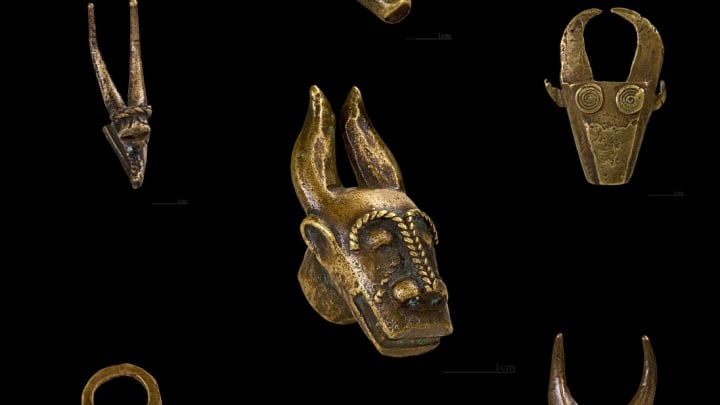The various forms of currency used throughout precolonial Africa are as unique and diverse as the people who call the continent home. From snail shells to magnificent swords, here are five forms of legal tender you won't find changing hands in modern markets today.
1. Cowries

Arab merchants are thought to have introduced the use of cowries—the shell of a sea snail (monetaria moneta)—as a currency to West Africans in the 8th century. Asian countries near the Pacific and the Indian Ocean also used this small porcelain shell as a legal tender.
Cowries emerged as an ideal currency in West Africa for several reasons, mainly because they’re rare and easy to carry around. They were often tied onto a string to make transporting and counting them easier. According to the British Museum, one string could consist of up to 40 cowries. Cowries stopped being used as a currency in the 20th century as European colonial governments introduced banknotes and coins.
2. Ngulu Sword

The Ngulu sword is one of the most remarkable currencies used in Africa. The bulky swords—which measured up to 23 inches or longer—were produced by the Ngombe tribe, although several neighboring ethnic groups in the Congo also used it.
The Ngulu, which looks like an elaborate sickle, is also known as the “executioner's sword.” Unlike the sickle, the outer part of the sword is the sharp end. It was allegedly used for ceremonial executions, but evolved into a prestige symbol after human sacrifice was outlawed. Some believe the brutal stories about this sword aren't factual, but were invented by imaginative Western writers like Edward James Glave to paint Africans as primitive. Chiefs and royals often danced with the Ngulu sword in their hands, and since it was generally regarded as a precious commodity, the sword was also used as a currency. The Ngulu gradually stopped being used as legal tender after the Belgian government introduced the Congolese Franc in the 20th century. Although the sword fell out of use, it hasn’t been forgotten. You'll find the Ngulu sword in museums across the world today, and in 2019, it was featured on an episode of History's Forged in Fire TV show.
3. Akan Gold Weights

Although they're called gold weights, these miniature figurines created by the Akan people of Ghana and Cote d’Ivoire were usually made of brass or copper [PDF]. Unlike other currencies, the Akan gold weights did not change hands during transactions. Instead, they were used as a standard to measure the weight of gold dust, which was the main currency. Blacksmiths carefully measured and recorded the exact weight of each piece.
The use of gold weights and gold dust as a form of currency among the Akan people is believed to have started in the 14th century. The weights were designed to represent nature, proverbs, and other cultural themes. They were used as a standard for all sorts of transactions, such as purchasing weapons, clothing, or food. Owning a complete set of gold weights was a sign of wealth, and was an important part of merchants’ accoutrements. The use of gold weights completely ceased after the British colonial government made the Pound Sterling the official currency of Ghana in 1899. The fact that these gold weights stand in museums around the world attests to their aesthetic appeal and historical significance.
4. Katanga Cross

The Katanga Cross was used as a currency across Central Africa between the 13th century (possibly earlier) and 20th century. It’s made of copper and has no distinct artistic features. It originated in Katanga, a copper-rich area in the southeastern part of the Democratic Republic of Congo. Only members of a mysterious secret society known as the bwanga were permitted to mine and work copper. Artisans made the cross by pouring molten copper into a molded clay enclosure.
The Katanga Cross was an important symbol of wealth and power, and prestigious people were sometimes buried with it. In the 19th and early 20th centuries, you could buy up to six chickens with one cross, and a gun with two. The cross stopped being used as a currency sometime in the mid-20th century, but continues to be a symbol of the rich history of the Katanga people. You will find it on the flag of the short-lived breakaway Republic of Katanga.
5. Kasai Velvet

Several ethnic groups in Congo used textile as a currency; one of the most popular was the Kasai velvet. The Shoowa people of Kuba in the Republic of the Congo have been making this textile since the 17th century. Although local legends say the Kuba people learned weaving from neighboring ethnic groups, they are more recognized for this craft today. The hand-woven Kasai velvet, which is usually less than 2 feet, is made of dyed fibers from raffia palm leaves. The cloth is decorated with colorful and rhythmic, traditional motifs. Men were responsible for harvesting the raffia palm and weaving it, while women added the designs.
The Shoowa people treasured this textile. It was rarely worn; instead, people used it ceremonially, as well as for payments and as gifts during events like coronations and marriages. The value of each piece depended on the complexity of the design and the length of the cloth. Some Shoowa people were buried with their textile wealth.
